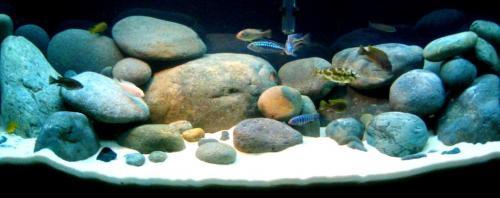Blanket Weed Prevention and Control
Blanket weed is all pond keepers nightmare !
Theres nothing frustrating than spending hours and hundreds of pounds to create an amazing pond only to be bogged down by Blanket Weed.
Left to establish Blanket Weed can soon smother every surface you have even covering the whole surface of the pond, leaving your pond drab and very un-attractive.
The good news is Blanket Weed is controllable and you can easily have a successful summer without seeing any blanket weed at all.
Your main fight against Blanket Weed is to understand why it grows and what is it using to grow.
Nutrients Blanket Weed Require to Grow
It's simpler than you think ... Blanket weed is an algae and algae are plants (and mainly green at that) and this means they love nitrogen, phosphorous and light. In pond water these chemical elements show up as NITRATES,PHOSPHATES and the Sun.
Nitrates and Phosphates are produced through the nitrification proccess and the addition of foods (Fish waste).
Remove one of these three elements and your sorted thats why come the winter months Blanket Weed dies off, but thats no good we don't want to get rid of the light through the summer, however we can help a little.
Sunlight
Theres nothing much we can do about sunlight and why would we want to hide our pond away in a completetly shaded area.
One thing we can do however is create a little area of shade, this will go down well in helping Blanket Weed control and also gives your fish a little area of shade, however don't use trees as shade, the roots of the tree could cause damage to your pond and the leaves falling into your pond will only add unwanted nutriants.
UV Filters / sterilisers
UV Filters go alongway in killing off algae spores before they can get a hold, if you havn't got one then get one these are a must have addition. Make sure the UV filter is sufficiant for your pond size. My advice always go a little bigger. A UV steriliser will also go alongway in helping with disease control.
Nitrate and Phosphates
Ok so you have a little shaded spot, you run a UV steriliser, now it's time to reduce your Nitrates and Phosphates. Easy said than done and this will take time but heres the first steps :
If you already have Blanket Weed then remove it and keep upto clearing it out of your pond, don't let it get a hold.
Test your Nitrates and Phosphates, this will give you a starting point to see that what you are doing is helping, however if you already have bad Blanket Weed it's possible these maybe low, don't be fooled the Blanket weed is using the Nitrates and Phosphates.
Clean you filter
Yes this can be a big bit of work but if you havn't cleaned it in a long time then it needs doing. remove all media and sponges and rinse in pond water, this also goes down as a water change for your pond. Use filtered water to top your pond back up, if possible use a nitrate and phoshpate media to remove these elements before adding the water to your pond.
If required replace your sponges. If your Sponge is your main media for bacteria then you will need to cut your sponge and replace with the new sponge in sections over a month or more, otherwise you will crash your pond filteration system.
Clean your pond.
Clean the bottom and the walls of your pond. Your pond bottom should be left empty, don't use gravel at the bottom of your pond as this will only add to your issue. However if you do want pebbles or stones then these need removing so you can get to the bottom of your pond. Rinse the stones / pebbles and put them back, if they have Blanket Weed on already then scrub the weed off.
After a week test your Nitrates and Phosphates again, have they reduced ?
Check stocking levels of your pond are you within the correct parameters ? overstocking will not help in reducing your Nitrate and Phosphate levels.
It's never easy in reducing your Nitrates and Phosphates but stick with it. Not many fishkeepers know that Phosphates and Nitrates go hand in hand and if one is higher then the other it can be difficult to bring one of them down, if they are both around the same level you will probably find it easier to bring down.
Plants
Plants are great at sucking up nitrates and phosphates as we know get some desirable pond plants in your pond, these will go along way in starving the Blanket weed of the nutriants it requires. Do some reading on plants faster growing plants will need more nutriants so these are a good starting point.
Chemical additives
Sometimes no matter what we do Blanket Weed will just not go using the natural methods above. So now it's time to add some additives to help.
There are alot of
Blanket Weed controllers around. Do read up before adding any chemical to your pond and always stick to the manufacturers instructions.
Why not try our range, we have the
Colombo Algisin which works wonders.
Remember prevention is better than the cure so try and keep upto your pond cleaning regime always do regular testing of your Nitrates and Phosphates before they peak.
I will go into detail of how we used or Marine Reef keeping skills to our Pond to get zero nitrates and phosphates in another post.
Good luck and Happy Fishkeeping !
Holiday Aquatics
www.holidayaquatics.com
















